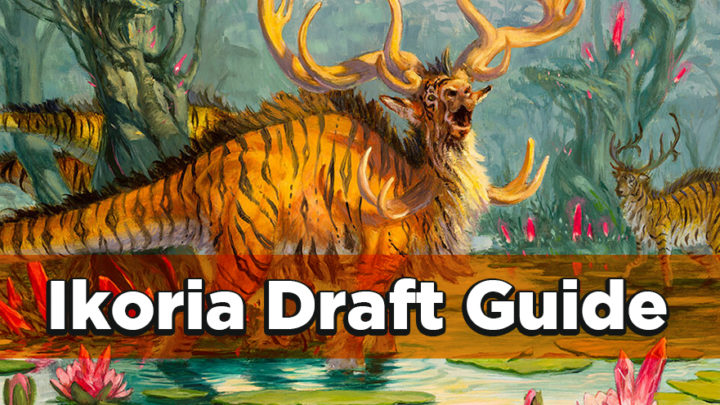Ikoria drafts went live on MTG Arena last week, and with it, we have several new ways to play. Many Magic players are excited to sink their teeth into this format, especially in the long-awaited player draft queues.
But players may also find Ikoria a bit more complicated than other recent sets. Multicolor draft formats force us to answer hard questions when we draft: How much should you prioritize nonbasic lands? Which cards are worth splashing? How can you tell what’s open when the players around you are drafting so many different colors? These are tough questions to answer, especially under player drafts’ timed conditions.
If you’re looking for a firmer footing while drafting Ikoria, we’ve got your back. In this draft guide, we’ll cover the set’s mechanics and major archetypes, as well as the cards you should keep your eye on at the draft table.
Mechanics
Ikoria includes several new mechanics that stretch the rules of Magic. Here’s a quick breakdown of all the mechanics and how they apply to Limited.
Mutate
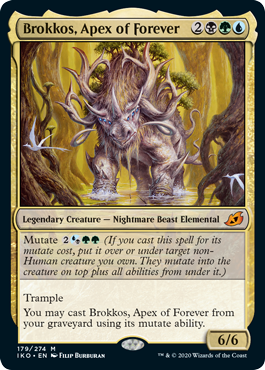
Ikoria is a plane full of monsters, and mutate allows you to create the biggest, scariest monsters possible. Mutate is an alternate cost that allows you to essentially combine one non-human creature with another (or several!).
A mutated creature is a single creature that has all the abilities of all creatures that were mutated. On Arena, when you mutate a creature, you’ll be prompted to put it over or under the creature it’s mutating with. The top creature determines the name, creature type, converted mana cost, and power and toughness of the mutated creature; in Limited, you’ll almost always want to choose the creature with the higher power and toughness.
You should also keep in mind that a mutated creature is a single creature that can be destroyed, exiled, or otherwise incapacitated by a single removal spell. In many of your games, you’ll have to weigh whether the benefit of getting a mutate trigger outweighs the risk of having your creature removed.
For more info on the mutate mechanic, check out this guide by Tom Anderson.
Companion
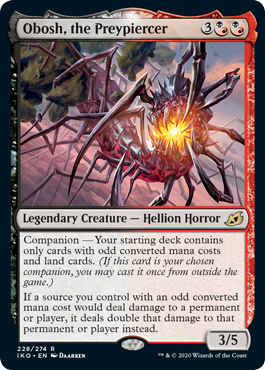
On Ikoria, you aren’t just creating creatures – sometimes, you’re creating lifelong bonds with them. The new companion mechanic allows you to choose a powerful creature whose abilities will determine how you build your deck.
Companions function a bit like commanders – you keep them in your sideboard and can cast them from there at any time. In Limited, any card that isn’t in your starting deck is in your sideboard. However, you may find it hard to build around a companion in Sealed or Draft, given the limits of your card pool. Thankfully, many of the companions are quite powerful and will serve you well in your main deck. We’ll cover a few of them in more detail later.
Ability Counters
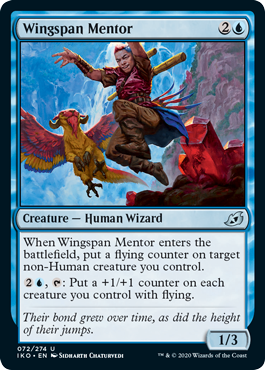
We’ve put many different types of counters on creatures over the years. What if we could add counters to creatures that gave them keyword abilities?
Ability counters do just that, and like other types of counters, there are plenty of effects that add or remove them. Note that these counters only grant keyword abilities, like trample or reach – they don’t grant additional power, toughness, or any other stats to creatures.
Cycling

It’s been about three years since we last saw cycling, but this versatile mechanic has worked its way back into a Standard-legal set.
Cycling is fairly straightforward: instead of casting a spell, you can discard it for its cycling cost to draw a new card. Cycling is especially useful in Limited when it’s attached to cards that you’d normally put in your sideboard, like artifact and enchantment removal spells. These cards become much more playable in the main deck when you have the option to cycle them away.
Cycling is also a valuable ability on spells with high converted mana costs, as it helps mitigate the risk of putting them in your deck. Stuck with a Greater Sandwurm in your hand and little else to do? Cycle it away and draw a fresh card! Plus, who knows – maybe you can recover that Sandwurm from your graveyard later.
Archetypes
Now that we’ve covered all the mechanics of Ikoria, let’s get into the decks that make the best use of them.
While Ikoria has a minor tri-color theme, most draft decks will have a two-color base. As such, it’s most helpful to learn the ten two-color archetypes. We’ll start with the five ally-color archetypes, which all revolve around keyword abilities.
White-Blue: Flying

Blue-White Flyers is a classic Limited archetype, but Ikoria’s version is on a whole different level. While you won’t find too many flyers in the set, flying counters and mutating flyers will give wings to creatures who wouldn’t have had them otherwise. Load up on common mutators like Dreamtail Heron and Vulpikeet, as well as any spells that give you a tempo advantage.
Blue-Black: Flash

Blue and black are all about casting spells on your opponent’s turn. There are plenty of creatures with flash in these colors, including the powerful Voracious Greatshark and Pouncing Shoreshark. If you’re in blue and black, you’ll likely be playing a control game with a higher-than-average removal spell count; this is probably the best place to take advantage of Capture Sphere.
Black-Red: Menace

Ikoria is a slower format, but there are some aggressive decks out there, including BR Menace. Many black and red creatures naturally have menace or gain menace counters on their own, but you’ll also find some good ways to help them out. You might end up in this archetype after picking up an early Blood Curdle or two; keep an eye out for Frillscare Mentor as well.
Red-Green: Trample

Many recent Limited formats have included a “Red-Green Big Creatures” archetype, and Ikoria is no exception. This archetype includes some of the set’s biggest monsters, and many of them have trample or another format of evasion. Some creatures with cycling or mutate will feel right at home here, and it’s best to choose one of those two lanes when drafting this archetype.
Green-White: Vigilance
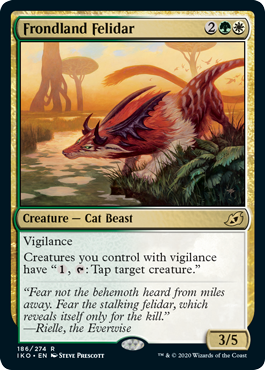
Finally, the green-white archetype revolves around vigilance. The most compelling reason to draft this archetype is Frondland Felidar, which can get in for damage while getting a blocker out of the way. You may also want to prioritize human tribal synergies when drafting this deck, though you’ll risk losing opportunities to mutate.
The keyword theme isn’t consistent across the other two-color archetypes, which have much broader themes and slightly more support at the uncommon rarity. Here’s what the enemy color pairs are up to:
White-Black: Humans

“Humans vs. Monsters” is a popular comic book trope, and it’s a major of this comics-inspired set. The humans of Ikoria may be small, but when they band together, they can be just as powerful as the monsters. This aggressive deck looks to go under the midrange monster archetypes, and it may include some cycling synergies.
Blue-Red: Spells
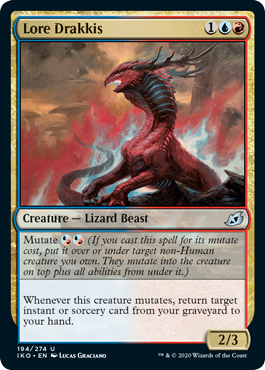
If you’re a fan of blue-red spell-based decks, don’t worry – it’s back in Ikoria! This deck will want plenty of cards with cycling, and it may contain some mutate synergies as well.
Black-Green: Graveyard
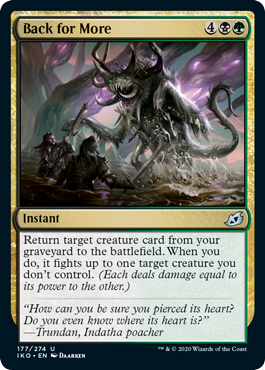
This deck wants to get maximum value out of its creatures by bringing them back from the graveyard again and again. There are plenty of ways to get creatures out of the graveyard, whether you’re mutating Boneyard Lurker or surprising your opponent with Back for More. Filling up your graveyard isn’t necessarily a priority; you’re mainly looking to re-cast a few value creatures or win an attrition game.
Red-White: Cycling

While some other archetypes can utilize cycling cards, red and white have the most and make the best use of them. Red-White Cycling is the premier aggressive deck and boogeyman of the format, with cheap payoffs like Valiant Rescuer, Drannith Stinger, and Zenith Flare at lower rarities. You won’t need to play many lands in this deck — it’s common to go as low as twelve or thirteen — so you can load up on off-color, one-mana cyclers.
Green-Blue: Mutate

Like cycling, mutate is ubiquitous in Ikoria, but mostly concentrated in two colors (in this case, blue and green). While this deck has weaker commons than some other archetypes, its uncommons – including Primal Empathy and Trumpeting Gnarr – can help you pull ahead if you’re at parity. Prioritize the two-mana Symbiotes (Essence Symbiote and Pollywog Symbiote) to tee up some impactful plays on later turns.
Playing Three or More Colors
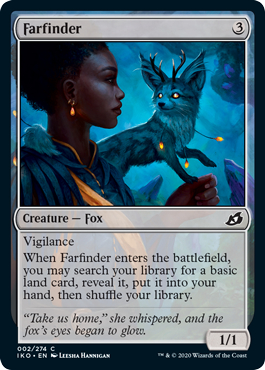
While two-color decks will be popular in the Ikoria draft queues, there are plenty of compelling reasons to include a third color. The three-color legendary creatures are some of the strongest in the set, and you may want to get maximum value out of a Mythos.
If you’re drafting a three-color deck, be sure to prioritize fixing. The Crystals – which tap for one of three colors – are well worth including, especially because you can cycle them if you don’t need them. The “gain lands” are also worth picking up, since the extra life points they provide help mitigate the tempo you lose by playing them. Farfinder and Fertilid are also great common creatures to draft if you think you’ll need to grab a land out of your deck.
Top Commons
Speaking of commons, here are the top cards that will form the building blocks of the draft format.
White: Pacifism

Pacifism is a premium removal spell in most limited formats, but it goes up in value when players start loading up creatures with mutations and ability counters. This cheap spell is exactly what aggressive white decks want in this format, whether they’re going wide with humans or racing with flyers.
Blue: Dreamtail Heron
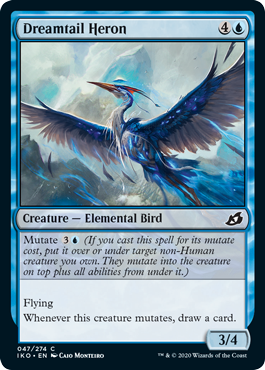
While Capture Sphere is another great answer to mutate creatures, a different blue common has really captured our attention. Dreamtail Heron often wins games on its own, especially when you put it on the back of a larger creature. Even a small Thieving Otter is a great accomplice for this sneaky bird. Your opponent might be able to remove Dreamtail Heron at some point, but as long as it resolves, it will at least replace itself.
Black: Blood Curdle
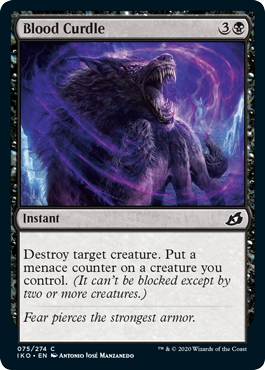
Not many removal spells make your own creatures harder to block, and Blood Curdle is in a league of its own as far as “win-the-game potential” is concerned. Give yourself a gold star if you put the menace counter on Bristling Boar.
Red: Fire Prophecy
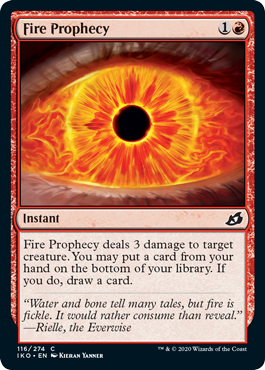
It’s hard to go wrong with a two-mana instant that deals three damage. Fire Prophecy also allows you to exchange unwanted cards for fresh ones, which is a welcome effect in red.
Green: Ram Through
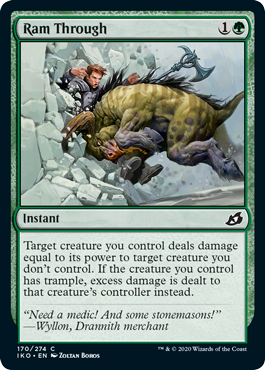
Green’s all about trample, and its premier common has a pseudo-trample effect. Ram Through is a key ingredient in any deck with large green creatures, especially because it’s one-sided (take that, deathtouch counters!).
Top Uncommons
Here are the uncommons that have impressed us most in our first week of Ikoria drafts.
White: Swallow Whole
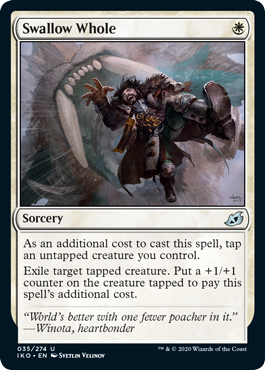
This one-mana removal spell doesn’t have much downside, especially when you have human tokens to spare.
Blue: Archipelagore
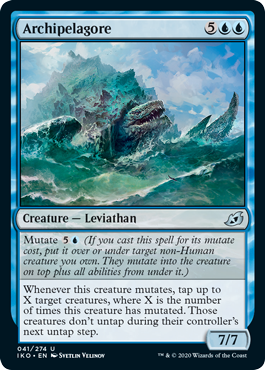
Talk about a great target for Dreamtail Heron! Archipelagore is one of blue’s mightiest mutants, and it often spells game over.
Black: Heartless Act
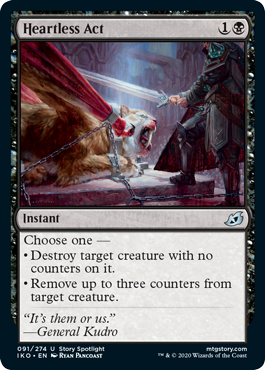
Modal spells are at a premium in best-of-one queues, and Heartless Act is the best one in Ikoria. While it won’t destroy as many creatures as Blood Curdle, it does take care of a lot of things, and its ability to remove ability counters can make combat rough for your opponents.
Red: Porcuparrot
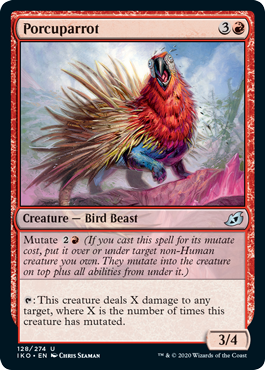
Creatures that don’t have to attack to deal damage are always useful in Limited; as long as Porcuparrot adapts once, it can ping your opponent indefinitely. Give this creature vigilance and you’re in business.
Honorable mention for red goes to Rooting Moloch, a creature that allows you to cast cards with cycling from your graveyard until the end of your next turn. That’s way more valuable than it looks!
Green: Auspicious Starrix

If you’re looking for a finisher for your mutate deck, a 6/6 creature that puts another permanent onto the battlefield is a great option. Even if you can’t mutate it, a five-mana 6/6 creature still gets the job done.
Multicolor: Zenith Flare

Zenith Flare is one of the most feared uncommons in Ikoria draft. In a dedicated cycling deck, this card can deal double-digit damage all on its own. A single Zenith Flare often means lights out, but a pair is nearly impossible to beat (and plausible, since it’s an uncommon).
Top Rares/Mythics
Finally, here are the rares and mythics to watch out for in Ikoria draft.
The Apexes
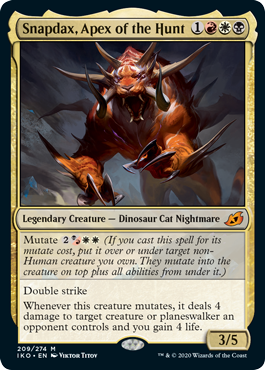
If you need a compelling reason to play a third color, look no further. The Apexes are among the strongest creatures in the format; Vadrok, arguably the weakest, can grant flying and first strike to any non-human creature. I’m personally keeping an eye out for Illuna and Snapdax.
The Companions
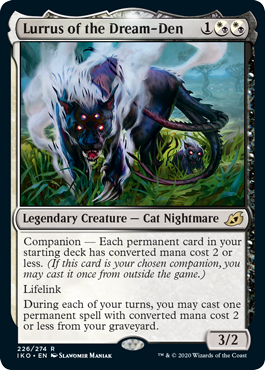
The companions are also powerhouses in Ikoria draft. Yorion is a 4/5 flyer that can blink Frost Lynx to tap down a blocker. Lurrus allows you to cast Dead Weight as many times as you want. Gyruda steals creatures from your opponents’ graveyards. What’s more, these creatures’ hybrid casting costs mean you can include them in a wide variety of decks. Snatch them up if you see them!
Luminous Broodmoth

If Luminous Broodmoth can’t get through for damage, it’ll help ensure that your other creatures can. This creature is sure to put your opponents in a bind.
Dirge Bat
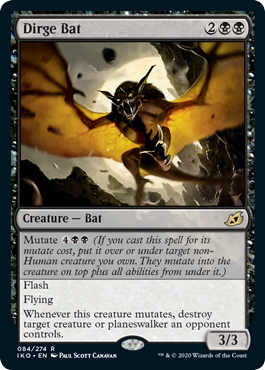
While Temur decks are best equipped to take advantage of mutate synergies, don’t count out some of the phenomenal black creatures with mutate. Dirge Bat is a flyer with flash or a repeatable instant-speed removal spell, either of which is fantastic in Limited.
Everquill Phoenix
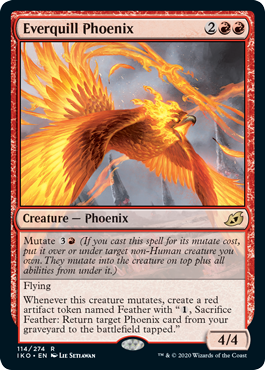
Sensing a pattern here? Flyers rule the roost on Ikoria, and Everquill Phoenix is a recursive one at that.
Kogla, the Titan Ape
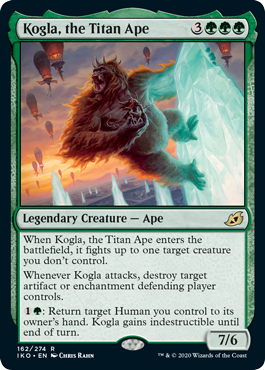
While his casting cost may be a bit prohibitive, Kogla always comes out swinging and has a host of useful abilities. A great fit for a green ramp or reanimator deck.
Crystalline Giant
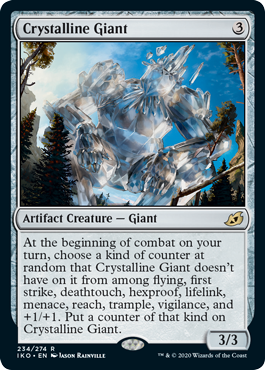
What can’t this creature do? If Crystalline Giant gets a hexproof counter early, beware.
Draft Time!
Want to see some Ikoria draft decks in action? Subscribe to our YouTube channel and check out weekly draft videos from Kenji “NumotTheNummy” Egashira!
Editor’s Note: This post has been updated throughout the lifespan of Ikoria: Lair of Behemoths draft to provide the most up-to-date card evaluations and metagame information. Date of last update: May 20, 2020.

Hallie served as Content Manager for CardKingdom.com and editor-in-chief of the Card Kingdom Blog from 2017-2022. Part tournament grinder, part content creator, Hallie is always looking for ways to improve her game and to share what she learns with others.

